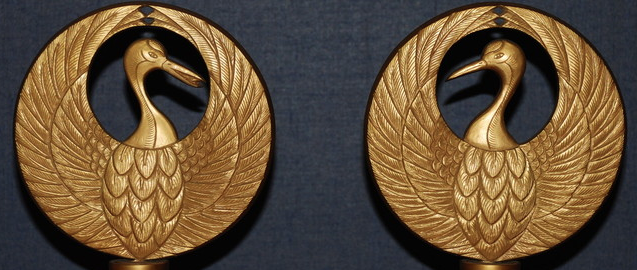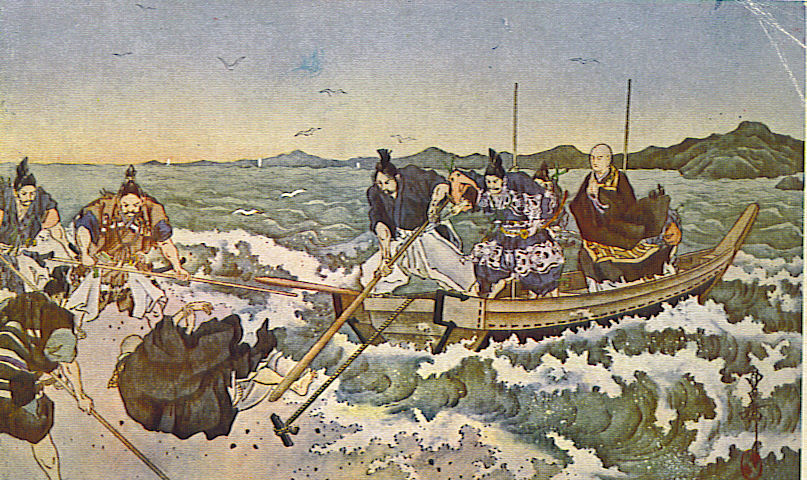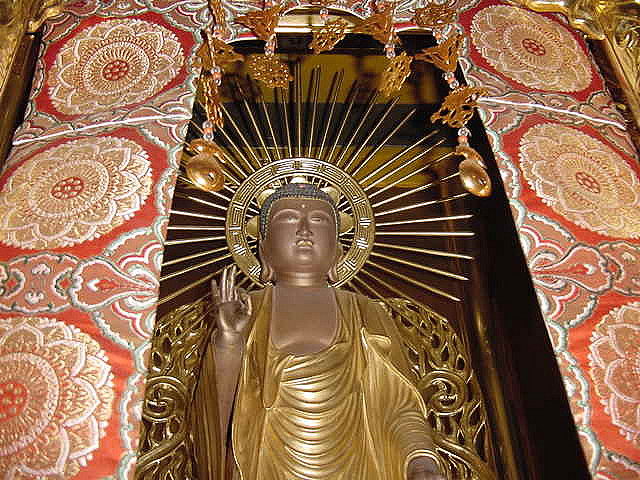|
Gohonzon
is a generic term for a venerated religious object in Japanese Buddhism. It may take the form of a scroll or statuary. The term typically refers to the mainstream use of venerated objects within Nichiren Buddhism, referring to the calligraphic paper mandala inscribed by the 13th Japanese Buddhist priest Nichiren to which devotional chanting is directed. Linguistically, the root word derives from ancient word , signifying a devotional object of respect or worship, and with the honorific prefix. Varying Nichiren groups accord their own meanings to the term in different ways, signifying their treatment of the object: * "Object of Devotion" — Soka Gakkai * "Object of Worship" — Nichiren Shōshū * "The Great Mandala, Venerated Supreme" — Nichiren-shū sects Paper scroll are sometimes known as or . The term is used for statuary. are often enshrined within an altar shrine (). Description Nichiren himself attached the greatest importance to his inscription of ... [...More Info...] [...Related Items...] OR: [Wikipedia] [Google] [Baidu] |
Nichiren Shōshū
is a branch of Nichiren Buddhism based on the traditionalist teachings of the 13th century Buddhism in Japan, Japanese Buddhist Bhikkhu#Monks in Japan, priest Nichiren (1222–1282), claiming him as its founder through his senior disciple Nikko Shonin (1246–1333), the founder of Taiseki-ji, Head Temple Taiseki-ji, near Mount Fuji. The lay adherents of the sect are called Hokkeko members. The Enichizan Myohoji Temple in Los Angeles, California, serves as the temple headquarters within the United States. The sect is known for vehemently rejecting the various forms of Buddhism taught by Shakyamuni Buddha as incomplete, expired and heretical for the Three Ages of Buddhism, Third Age of Buddhism. Instead, the sect is based on the exclusivist teachings of Nichiren and the chanting of "Nam-Myoho-Renge-Kyo" along with reciting curated portions of the Lotus Sutra. The object worshipped by its believers is the ''Dai Gohonzon'' while its religious symbol is the rounded crane bird. Bot ... [...More Info...] [...Related Items...] OR: [Wikipedia] [Google] [Baidu] |
Nichiren-shū
is a combination of several schools ranging from four of the original Nichiren Buddhism, Nichiren Buddhist schools that date back to Nichiren's original disciples, and part of the fifth: Overview The school is often referred to as the Minobu Sect due to its prominence within the Mount Minobu area. The school's head temple, Kuon-ji, is located on Mount Minobu where Nichiren lived in seclusion and where he asked to be buried. Another significant temple of the sect is the Ikegami Honmon-ji where Nichiren died. Accordingly, many of Nichiren's most important personal artifacts and writings, also considered to be National Treasures of Japan, are within their safekeeping. The sect is also known for its more open and tolerant views of other Buddhist traditions, even mixing or incorporating various mixed Buddhist beliefs and Shinto practices into their own aesthetics, most notably the use of various religious statues, the red stamping practice of Shuin for novelty, esoteric combinati ... [...More Info...] [...Related Items...] OR: [Wikipedia] [Google] [Baidu] |
Soka Gakkai
is a Japanese new religions, Japanese new religion led by Minoru Harada since December 2023 based on the teachings of the 13th-century Buddhist priest Nichiren. It claims the largest membership among Nichiren Buddhism, Nichiren Buddhist groups. The organization bases its teachings on Nichiren's interpretation of the ''Lotus Sutra'' and places chanting Namu Myōhō Renge Kyō, Nam Myōhō Renge Kyō at the center of devotional practice. The organization promotes its goals as supporting "peace, culture, and education". Soka Gakkai was founded by educators Makiguchi and Toda on 18 November 1930, and held its inaugural meeting in 1937. It was disbanded during the Second World War when much of the leadership was imprisoned for violations of the Peace Preservation Law#Public Security Preservation Law of 1925, 1925 Peace Preservation Law and charges of lèse-majesté. After the war, its expansion was led by its former third president Daisaku Ikeda. In Japan, Soka Gakkai is the head ... [...More Info...] [...Related Items...] OR: [Wikipedia] [Google] [Baidu] |
Nichiren
was a Japanese Buddhist priest and philosopher of the Kamakura period. His teachings form the basis of Nichiren Buddhism, a unique branch of Japanese Mahayana Buddhism based on the '' Lotus Sutra''. Nichiren declared that the '' Lotus Sutra'' alone contains the highest truth of Buddhism and that it is the only sutra suited for the Age of Dharma Decline. He insisted that the sovereign of Japan and its people should support only this form of Buddhism and eradicate all others, or they would face social collapse and environmental disasters. Nichiren advocated the faithful recitation of the title of the ''Lotus Sutra'', '' Namu Myōhō Renge Kyō'', as the only effective path to Buddhahood in this very life, a path which he saw as accessible to all people regardless of class, education or ability. Nichiren held that Shakyamuni and all other Buddhist deities were manifestations of the Original Eternal Buddha (本仏 ''Honbutsu'') of the ''Lotus Sutra'', which he equated with t ... [...More Info...] [...Related Items...] OR: [Wikipedia] [Google] [Baidu] |
Nichiren Buddhism
Nichiren Buddhism (), also known as ''Hokkeshū'' (, meaning ''Lotus Sect''), is a branch of Mahayana Buddhism based on the teachings of the 13th-century Japanese Buddhist priest Nichiren (1222–1282) and is one of the Kamakura period schools. Its teachings derive from some 300–400 extant letters and treatises either authored by or attributed to Nichiren. Nichiren Buddhism generally sources its basic doctrine from the Lotus Sutra claiming that all sentient beings possess an internal Buddha-nature capable of attaining Buddhahood in the current life. There are three essential aspects to Nichiren Buddhism: # The faith in Nichiren's '' Gohonzon'' # The chanting of '' Nam Myoho Renge Kyo'' with varying recitations of the Lotus Sutra # The study of Nichiren's scriptural writings, called ''Gosho'' After his death, Nichiren left to both his senior disciples and lay followers the mandate to widely propagate the ''Gohonzon'' and chanting the '' Daimoku'' in order to secure the p ... [...More Info...] [...Related Items...] OR: [Wikipedia] [Google] [Baidu] |
Three Great Secret Laws
(or also "Three Great Secret Dharmas") are the fundamental teachings in Nichiren Buddhism, which include Hommon-no- honzon (本門の本尊: object of devotion of the essential teaching), Hommon-no-kaidan (本門の戒壇: sanctuary of the essential teaching), and Hommon-no- daimoku (本門の題目: daimoku of the essential teaching). The interpretations of each item are different by each school of Nichiren's teachings, such as Nichiren Shu sects, Nichiren Shoshu sects, Soka Gakkai is a Japanese new religions, Japanese new religion led by Minoru Harada since December 2023 based on the teachings of the 13th-century Buddhist priest Nichiren. It claims the largest membership among Nichiren Buddhism, Nichiren Buddhist group ... branches. (The table is summarized from the texts by each sect.) Further reading ・ The collections of Nichiren's writings by each sect. ・Nichikan (1725). ''Rokkan-shō'' (Six-Volume Writings). ・Montgomery, Daniel (1991). ''Fire in the Lot ... [...More Info...] [...Related Items...] OR: [Wikipedia] [Google] [Baidu] |
Honzon
, sometimes referred to as a Gohonzon ( or ), is the enshrined main image or principal deity in Japanese Buddhism. The buddha, bodhisattva, or mandala image is located in either a temple or a household butsudan. The image can be either a statue or a small scroll and varies from sect to sect. It can be a singular image or a group of images; the ''honzon'' in the main (''hondō'') or treasure (''kondō'') hall of the temple can be for that particular hall or the entire temple complex. Sometimes ''honzon'' is the central image (''chūson'') of a cluster of three (''sanzonbutsu'') or five (''goson'') images. The physical creation of an icon is followed by a consecration ceremony (known as ''kaigen'', literally 'opening the eyes' or 'dotting the eyes'). It is believed this transforms the ''honzon'' into a 'vessel' of the deity which in its own right has power. Butsuzō A honzon that takes the form of a statue is called a ''Butsuzō'' () or ''Honzonbutsu'' (), most likely crafte ... [...More Info...] [...Related Items...] OR: [Wikipedia] [Google] [Baidu] |
Omamori
are Japanese amulets commonly sold at Shinto shrines and Buddhist temples, dedicated to particular Shinto as well as Buddhist figures and are said to provide various forms of luck and protection. Origin and usage The word means 'protection', with being the (honorific) form of the word. Originally made from paper or wood, modern amulets are small items usually kept inside a brocade bag and may contain a prayer, religious inscription of invocation. are available at both Shinto shrines and Buddhist temples with few exceptions and are available for sale, regardless of one's religious affiliation. are then made sacred through the use of ritual, and are said to contain (spiritual offshoots) in a Shinto context or (manifestations) in a Buddhist context. While are intended for temple tourists' personal use, they are mainly viewed as a donation to the temple or shrine the person is visiting. Visitors often give as a gift to another person as a physical form of well-wishi ... [...More Info...] [...Related Items...] OR: [Wikipedia] [Google] [Baidu] |
Namu Myōhō Renge Kyō
''Namu Myōhō Renge Kyō'' (Kanji: ) is a Japanese sacred phrase chanted within all forms of Nichiren Buddhism. In English, it means "Devotion to the Mystic Dharma of the ''Lotus Flower Sutra''" or "Homage to the Sublime Dharma of the ''Lotus Sutra''". The words refer to the Japanese title of the ''Lotus Sūtra'' (Sanskrit: ''Saddharmapuṇḍarīkasūtra''). The phrase is referred to as the () or, in honorific form, () meaning ''title'', and was publicly taught by the Japanese Buddhist priest Nichiren on 28 April 1253 atop Mount Kiyosumi, now memorialized by Seichō-ji temple in Kamogawa, Chiba prefecture, Japan. In Nichiren Buddhism, the practice of prolonged Daimoku chanting is referred to as (). Nichiren Buddhist believers claim that the purpose of chanting is to reduce suffering by eradicating negative karma and all karmic retribution, while also advancing the practitioner on the path to perfect and complete awakening. History '' Lotus Sutra'' devotion had a l ... [...More Info...] [...Related Items...] OR: [Wikipedia] [Google] [Baidu] |
Mandala
A mandala (, ) is a geometric configuration of symbols. In various spiritual traditions, mandalas may be employed for focusing attention of practitioners and adepts, as a spiritual guidance tool, for establishing a sacred space and as an aid to meditation and trance induction. In the Eastern religions of Hinduism, Buddhism, Jainism and Shinto it is used as a map representing deities, or especially in the case of Shinto, paradises, kami or actual shrines. Hinduism In Hinduism, a basic mandala, also called a '' yantra'', takes the form of a square with four gates containing a circle with a centre point. Each gate is in the general shape of a T. Mandalas often have radial balance. A '' yantra'' is similar to a mandala, usually smaller and using a more limited colour palette. It may be a two- or three-dimensional geometric composition used in '' sadhanas'', puja or meditative rituals, and may incorporate a mantra into its design. It is considered to represent the abode ... [...More Info...] [...Related Items...] OR: [Wikipedia] [Google] [Baidu] |
Butsudan
A , sometimes spelled butudan, is a shrine commonly found in temples and homes in Japanese Buddhist cultures. A ''butsudan'' is either a defined, often ornate platform or simply a wooden cabinet sometimes crafted with doors that enclose and protect a '' gohonzon'' or religious icon, typically a statue or painting of a Buddha or bodhisattva, or a calligraphic mandala scroll. The butsudan's primary use is for paying respects to the Buddha, as well as to family members who have died. Arrangement A ''butsudan'' usually contains an array of subsidiary religious accessories, called ''butsugu'', such as candlesticks, incense burners, bells, and platforms for placing offerings such as fruit, tea or rice. Some Buddhist sects place '' ihai'' memorial tablets, ''kakochō'' death registers for deceased relatives, or urns containing the cremated remains of relatives, either within or near the ''butsudan''. The defined space which occupies the Butsudan is referred to as ''Butsuma''. If t ... [...More Info...] [...Related Items...] OR: [Wikipedia] [Google] [Baidu] |
Japanese Buddhism
Buddhism was first established in Japan in the 6th century CE. Most of the Japanese Buddhists belong to new schools of Buddhism which were established in the Kamakura period (1185-1333). During the Edo period (1603–1868), Buddhism was controlled by the feudal Shogunate. The Meiji period (1868–1912) saw a strong response against Buddhism, with persecution and a forced separation between Buddhism and Shinto ('' Shinbutsu bunri''). The largest sects of Japanese Buddhism are Pure Land Buddhism with 22 million believers, followed by Nichiren Buddhism with 10 million believers, Shingon Buddhism with 5.4 million, Zen Buddhism with 5.3 million, Tendai Buddhism with 2.8 million, and only about 700,000 for the six old schools established in the Nara period (710-794). History Early Buddhism (5th-13th century) Arrival and initial spread of Buddhism Originating in India, Buddhism arrived in Japan by first making its way to China and Korea through the Silk Road and then tr ... [...More Info...] [...Related Items...] OR: [Wikipedia] [Google] [Baidu] |









